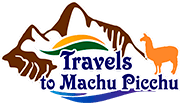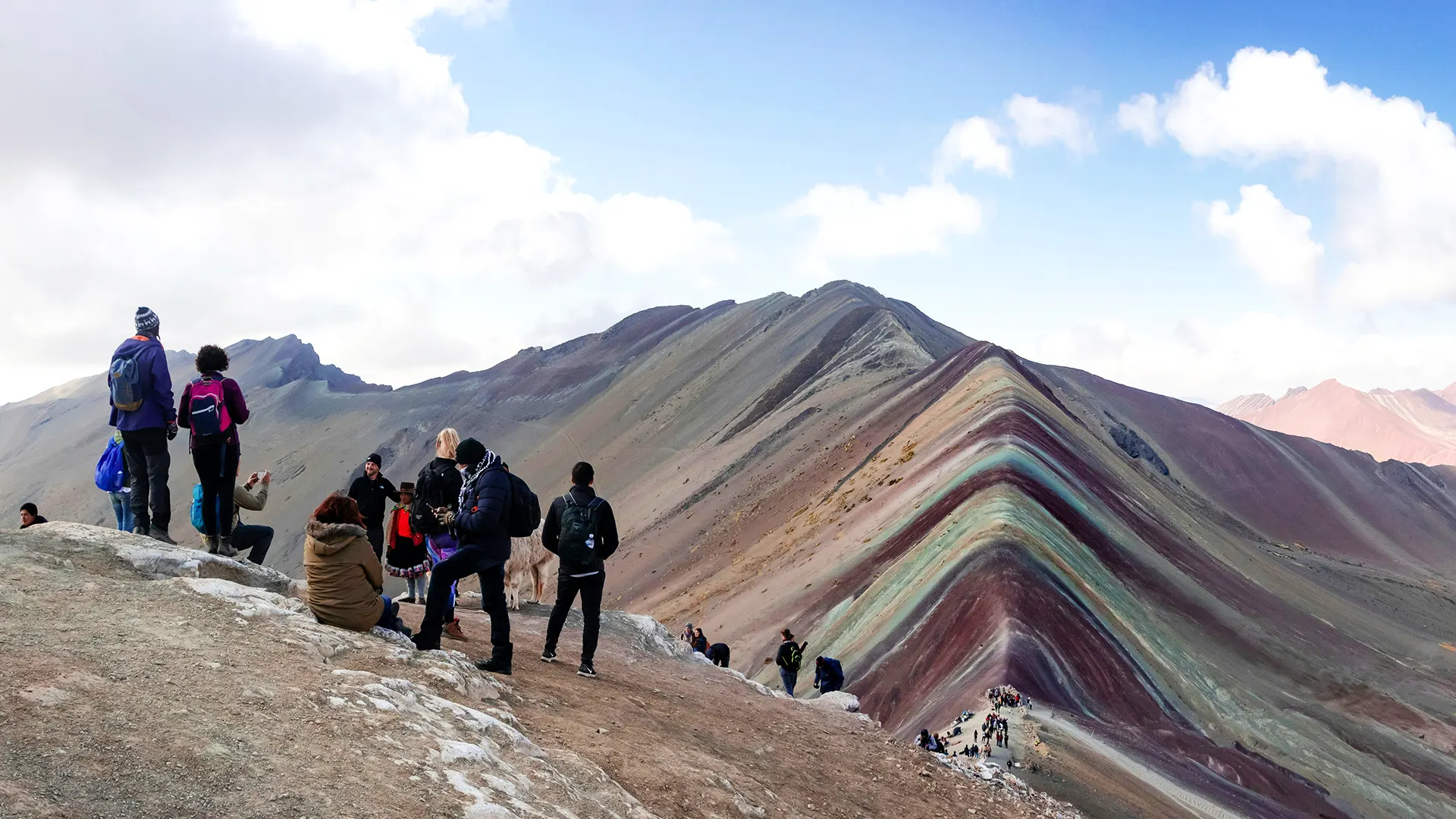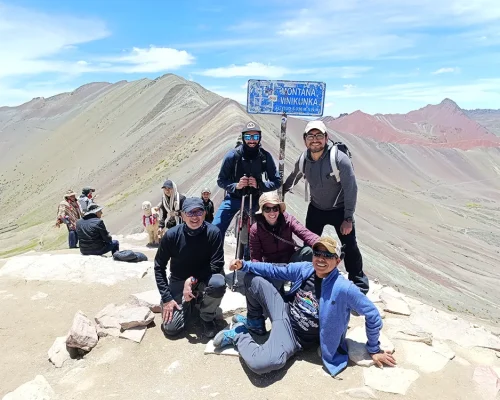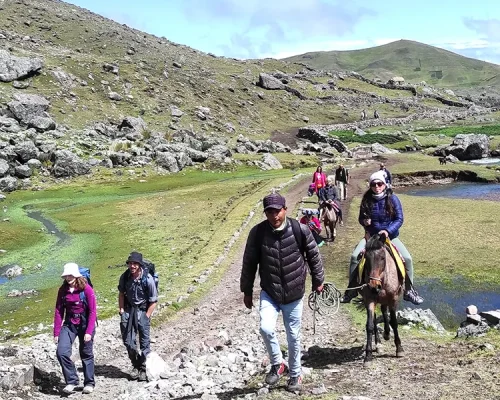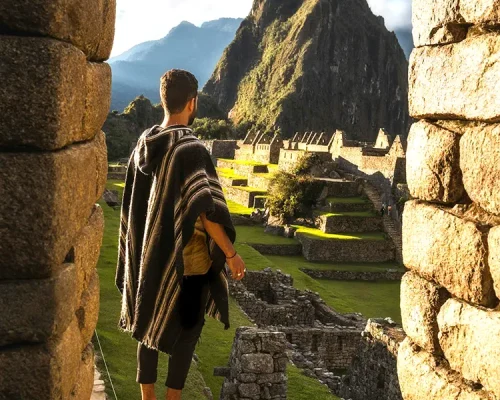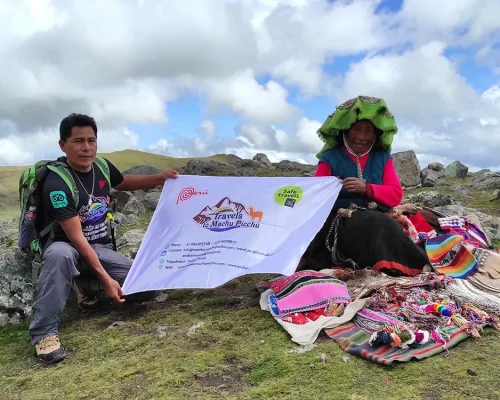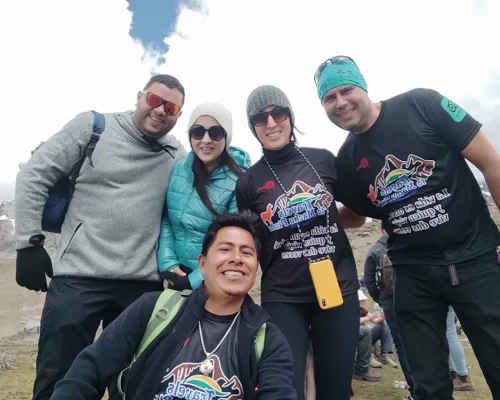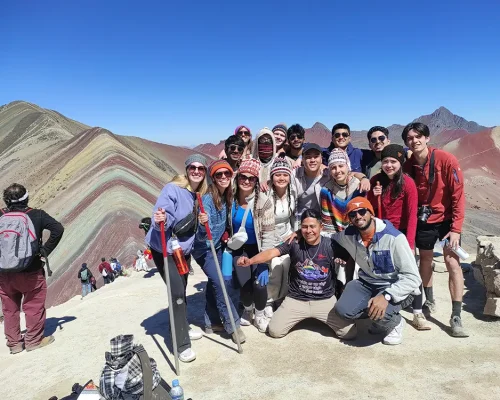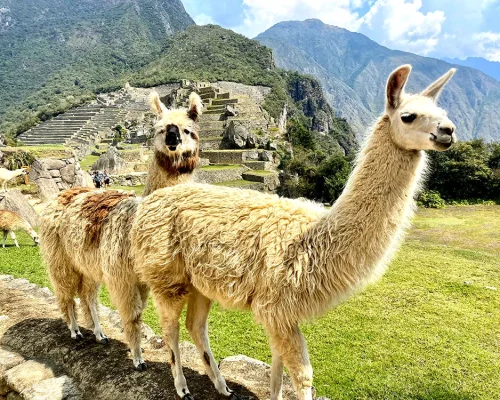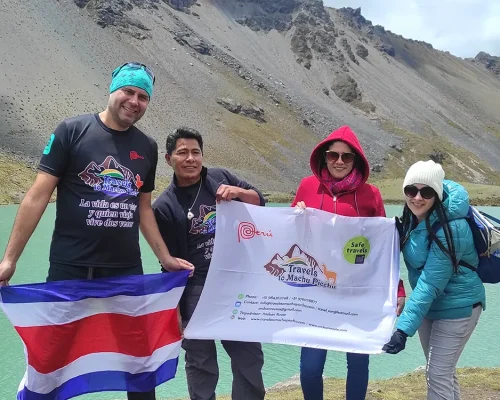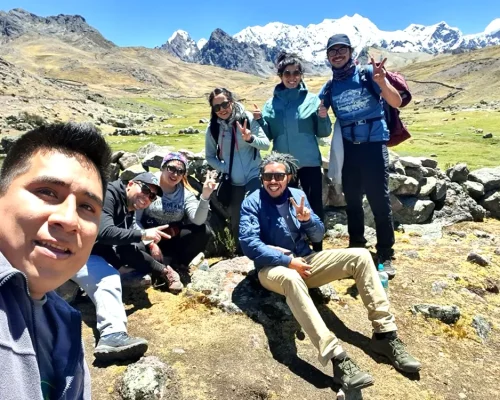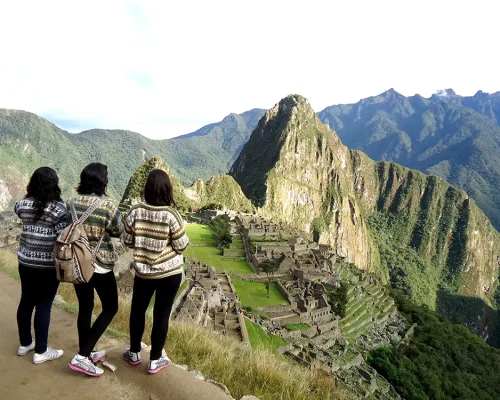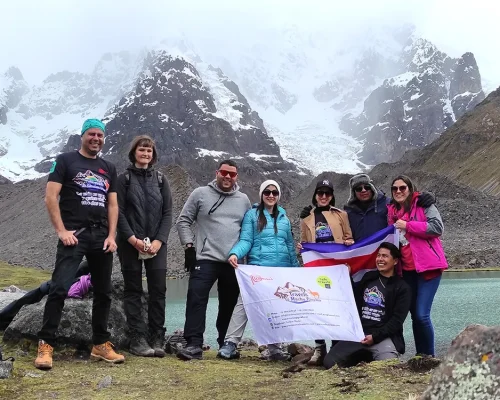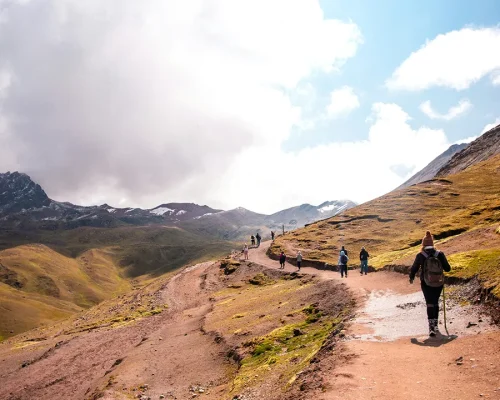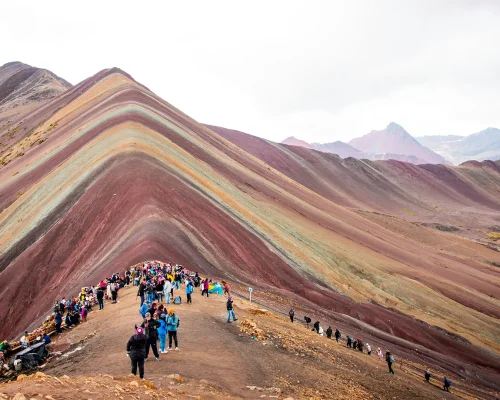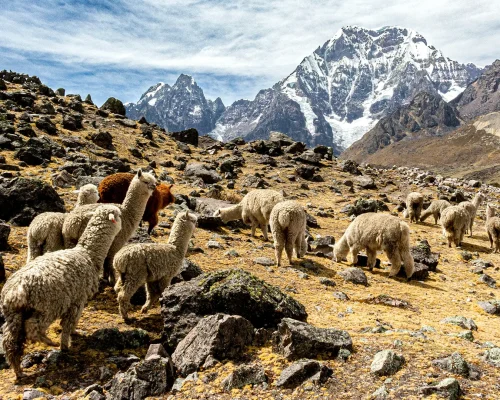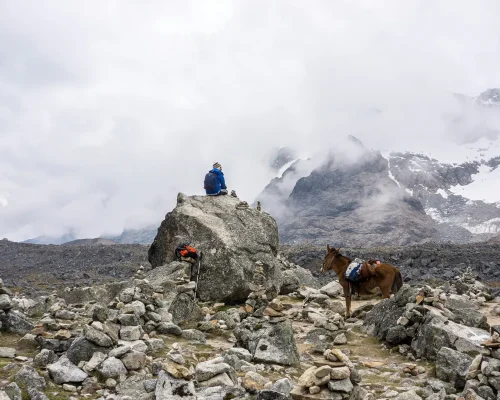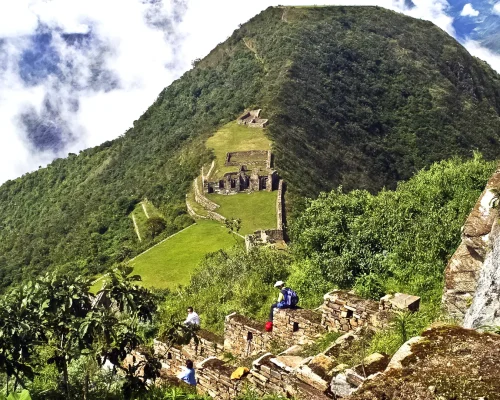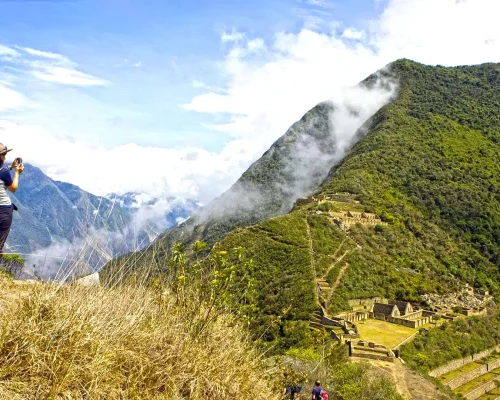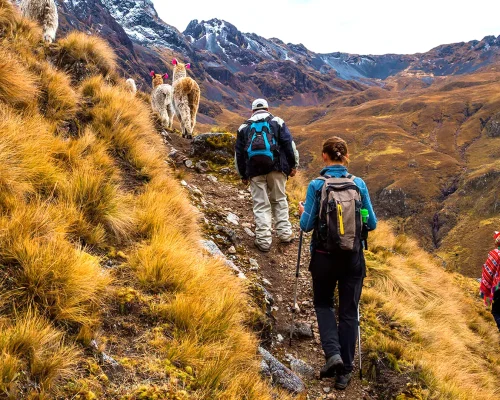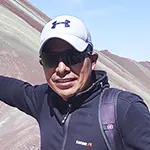Overview
Embark on an unforgettable 4-day adventure through the heart of Peru, where ancient traditions meet breathtaking landscapes. This journey offers a perfect blend of culture, history, and nature as you traverse rugged mountain trails, interact with local communities, and marvel at spectacular vistas. Every step of your trek is supported by professional guides and a dedicated team, ensuring both safety and comfort while immersing you in the rich Andean heritage.
Experience the magic of the Peruvian highlands as you explore iconic sites, from the mystical Rainbow Mountain to the ancient ruins of Machu Picchu. With a well-structured itinerary that balances challenging hikes and moments of relaxation, you’ll have ample time to savor the region’s unique flavors, traditions, and natural beauty. This adventure is thoughtfully designed to cater to various hiking abilities while promising an enriching and memorable journey.
Day-by-Day Itinerary
- Day 1: Cusco– Pukutuni School – Pucaccocha
- Day 2: Pucaccocha – Condor pass – Alpaca pass – Sororni Lake
- Day 3: Soroni Lake – Rainbow Mountain – Kayrawiri – drive to Ollantaytambo and train to Aguas Calientes
- Day 4: Machu Picchu & return to Cusco
Itinerary
Day 1: Cusco – Pukutuni School – Pucaccocha
The Rainbow Mountain Trek team from Travels to Machu Picchu will pick you up in Cusco at 4:00 a.m. You’ll enjoy a scenic three-hour drive to the trailhead at Pukutuni School. Upon arrival, indulge in a hearty breakfast and meet your locally based support crew—chef, porters, and horsemen.
After breakfast, embark on a three-hour hike to the village of Upis, nestled at the base of Ausangate Mountain. Here you’ll savor a freshly prepared Andean lunch. Refueled, tackle a 1.5-hour uphill trek to Vicuña Pass (4,850 m), pausing to soak in sweeping vistas of valleys, waterfalls, glacier peaks and grazing vicuñas.
The final leg of Day 1 is a three-hour walk to your evening camp at Pucaccocha, following crystal streams and alpine meadows. Your chef and porters will have dinner ready and tents pitched—just relax under the Andean sky and enjoy the tranquility.
Day 2: Pucaccocha – Condor Pass – Alpaca Pass – Sororni Lake
Rise early for a nutritious breakfast prepared by your Travels to Machu Picchu chef. Then ascend for two hours to Condor Pass (4,900 m), with magical views of Ausangate’s snow-draped peaks, sapphire lagoons, and the chance to spot llamas and alpacas grazing along the ridges.
Enjoy a gradual two-hour descent to your lunch spot, where a hot meal awaits. Post-lunch, undertake a shorter climb—about one hour—to Alpaca Pass (4,950 m), offering partial glimpses of Rainbow Mountain’s vibrant strata. A one-hour downhill brings you to the shores of Sororni Lake, your campsite for the night. Here, unwind and marvel at the Andean constellations.
Day 3: Sororni Lake – Rainbow Mountain – Drive to Ollantaytambo – Train to Aguas Calientes
Spending the night by Sororni Lake means you’ll be among the first to reach Rainbow Mountain. After a warm breakfast and hot drinks from your team, set out on a two-hour uphill hike to the mountain’s base. Along the trail, observe herds of wild vicuñas against a backdrop of multi-hued slopes.
Upon arrival, enjoy unobstructed views before crowds arrive. Your guide will explain the mineral composition responsible for each color band. When you’re ready, descend for one hour back to the trailhead. Here you’ll say goodbye to your trekking team and continue with your dedicated Rainbow Mountain Trek guide.
From the trail’s end, it’s a four-hour drive to Ollantaytambo, where you’ll have dinner in the old Inca town. At 7:00 p.m., board the train to Aguas Calientes, arriving in time for a hot shower and a restful night in a local hotel.
Day 4: Machu Picchu & Return to Cusco
Day 4 is dedicated to the world-famous Machu Picchu. Begin with breakfast in Aguas Calientes, then catch one of the first buses (starting around 5:30 a.m.) to the citadel. Your hotel will hold your belongings, so you only carry a day pack.
It’s a 30-minute bus ride to the site. Upon arrival, your guide will introduce you to Machu Picchu’s main sectors, first leading you to the optimal sunrise viewpoint for spectacular photos. Then enjoy a 2.5-hour walking tour that delves into Inca history, architecture, and culture.
After the guided segment, participants have free time to explore the ruins on their own or embark on an optional Huayna Picchu hike (advance booking required; sells out quickly; single-entry fee applies). Your guide will point out the trailhead and provide tips for the roughly two-hour round-trip climb.
We recommend departing Machu Picchu at least two hours before your scheduled train back to Ollantaytambo. Your guide will confirm train times in advance. The return train journey takes about two hours. In Ollantaytambo, the Travels to Machu Picchu staff will meet you at the station exit and drive you back to Cusco—a roughly two-hour ride—arriving in the early evening.
You also have the option to hike Machu Picchu Mountain instead of Huayna Picchu. This alternative is more challenging and requires a minimum three-hour round-trip effort (additional cost applies).
Inclusions
Included
- Professional Guides
- Briefing
- Porters & Horsemen
- Emergency Horse
- Transportation
- Equipment
- Food
- Water
- First Aid
- Extras
Not Included
- Sleeping Bag: $20
- Inflatable Air Mattress: $15
- Walking Sticks (Pair): $15
Before You Go
Data about Peru
Peru is a country of great cultural and geographic diversity, located on the western coast of South America. The official language is Spanish, spoken by the majority of the population.
Peru’s official currency is the sol (PEN), which is accepted throughout the country. Additionally, there are many currency exchange houses in the main cities and tourist areas, where travelers can exchange currencies such as the U.S. dollar, the euro, the Japanese yen, among others.
Peru is world-renowned for its rich cultural heritage, spanning from ancient Andean civilizations like the Incas to the Spanish influence that left its mark on the country’s architecture, cuisine, and traditions. Its economy is one of the most dynamic in Latin America, and Peruvian fashion, influenced by its textile traditions, has gained international recognition, especially for its alpaca and innovative designs using natural and sustainable materials.
The climate in Peru varies greatly by region: the coast has a desert climate, the Andean areas are cold, while the Amazon rainforest enjoys a warm and humid climate year-round. Each region has its own charm and is an invitation to explore not only the landscapes but also the cuisine, history, and traditions that make this country a unique destination.
Arriving in Cusco
The Cusco airport is exclusively equipped for domestic flights. Therefore, all international travelers must land in Lima and go through Customs. Although your flight to Cusco may be operated by the same airline and on the same day, you will need to collect your luggage in Lima and recheck it for the flight to Cusco.
Flying is the quickest and most comfortable option to reach Cusco, with several airlines operating this route. While LAN is usually the most expensive, it offers many alternatives and schedules to fit your planning.
Weather in Cusco
The weather in Cusco is primarily temperate and dry, with a rainy season from November to March. During the dry season, from April to October, daytime temperatures are more pleasant, but nights can be cold due to the altitude. Daytime temperatures typically range between 15°C and 20°C, while nighttime temperatures can drop to 0°C or below.
Altitude
When booking a trip to Cusco, it is natural to have concerns about altitude sickness. Cusco’s altitude means that the air contains less oxygen, which forces your body to work harder to obtain the necessary oxygen.
It is recommended that you spend at least two days in Cusco before starting any treks in the Andes to allow your body to acclimate. Cusco is a fascinating city, full of activities, so you won’t be bored during your acclimatization period.
Altitude sickness can initially present with symptoms similar to those of a cold or hangover. Symptoms include headaches, fatigue, loss of appetite, nausea, dizziness, sleep problems, and difficulty breathing during exercise. If symptoms worsen, it is important to contact our office so that we can assist you and arrange for a medical consultation.
Generally, the symptoms are mild, so it is recommended to take things slowly to allow your body to adjust. Stay well hydrated by drinking water or coca tea, which has been used for centuries to prevent the effects of altitude sickness. Coca leaves contain alkaloids that help oxygen circulate in the blood. Avoid excessive consumption of alcohol and coffee, as they dehydrate the body. It is also important to avoid smoking and taking sleeping pills, as these hinder oxygen absorption.
Remember that the trek to Machu Picchu is not a race. Even the fittest individuals can experience altitude sickness if they rush too much. Go slowly and allow your body to adjust to the altitude.
Your doctor may recommend medications such as acetazolamide to prevent altitude sickness, which you should begin taking two days before reaching high altitude.
Group Tours
Group tours may include people with varying hiking abilities and ages. When joining one of these tours, be prepared for the group’s pace to vary, as some participants may move faster or slower than you. Everyone can walk at their own pace, and the guide will work to ensure that everyone enjoys the experience. The groups may request some modifications to the itinerary, and the guide will make the best decisions to ensure everyone’s comfort.
Strikes and Protests
Unfortunately, strikes are common in Peru and can disrupt tour itineraries. Protests may block roads or halt trains. In the event that these issues arise, we will ensure that your itinerary continues as planned, even if this means departing earlier than expected. If it becomes necessary to cancel any tour, our operations team will contact you to coordinate the best possible solutions. The safety of our clients is always our priority.
Lost Items
You are responsible for your belongings throughout the journey. We recommend that you pay attention to where you leave your items and make sure to collect everything from our vans, camps, or restaurants. Do not leave your belongings unattended, as it is possible that other travelers may pick them up without knowing who they belong to.
Travel Insurance
Travel insurance is an affordable and highly recommended option. Although trips are planned months in advance, there is always the possibility of unforeseen events.
Adventure travel carries a higher risk, so having adequate insurance will protect your investment. If you wish, we can help you contact an insurance agent who can advise you on the proper coverage.
First Aid
Every guide from Travels to Machu Picchu has been trained in first aid by medical professionals. We conduct annual training sessions to stay updated and prepared for any emergency. During the tour, each guide carries a first aid kit with basic medications, such as those for traveler’s diarrhea, as well as oxygen.
If you ever feel that you cannot continue the trek, our guides will know the safest and quickest way to get you to a place where you can receive medical attention. We will never leave you alone; there will always be a team member who will accompany you until you are in the hands of a doctor. If necessary, we will ensure that you can visit Machu Picchu at a later time and rejoin your group.
Environmental Impact
At Travels to Machu Picchu, we are committed to respecting the environment. We use biodegradable soap and take care of transporting all our trash back to Cusco. Our porters are trained to take care of the trails and collect any waste they may find from other groups. Additionally, we use eco-friendly portable toilets, which allow us to pack up waste and leave no trace in the natural surroundings. We believe in the importance of practicing responsible and sustainable tourism.
Packing List
Recommendations
- Waterproof Hiking Boots: Sturdy, broken-in boots with ankle support to navigate rocky, uneven trails.
- Layered Clothing: Moisture-wicking base layers, a warm fleece mid-layer, and a breathable, waterproof shell for changing weather.
- Insulated Jacket: A lightweight, packable jacket to keep you warm during morning starts and evening chills.
- Sun Protection: Sunglasses, a wide-brimmed hat, and high-SPF sunscreen to shield you from intense Andean UV rays.
- Rain Gear: A compact poncho or waterproof jacket and pants to stay dry during sudden mountain showers.
- Trekking Poles: Adjustable poles to improve balance and reduce strain on knees during ascents and descents.
- Hydration System: A refillable water bottle or hydration bladder to carry at least 2 liters of water each day.
- High-Energy Snacks: Trail mix, energy bars, or dried fruit for quick refueling between meals.
- Headlamp with Extra Batteries: Essential for early starts, campsite navigation, and any unexpected delays.
- Camera or Smartphone: Extra memory cards and batteries to capture every stunning vista.
- First-Aid Kit: Basic supplies, including blister care, pain relievers, and personal medications.
- Ticket Vouchers: Printed and digital copies of your entrance tickets and train vouchers—no need to carry extra cash for these, as they are arranged for you.
- Local Currency Cash: Small bills for souvenirs, tips, or any personal expenses along the way.
Price
Join us on this unforgettable 4-day adventure along Rainbow Mountain, Ausangate and Machu Picchu for USD 600 per person. This price includes everything you need for a seamless and memorable experience: transportation, professional guides, permits, food, and more.
Please note that this tour requires a minimum of two participants. Gather your friends or family and embark on this incredible journey together!
Frequently Asked Questions
What is the best season and weather to visit the Rainbow Mountain, Ausangate, and Machu Picchu?
The best window is the dry season (April–October), with more stable skies and a higher chance of clear views in both the Rainbow Mountain (approx. 5,000 m) and the Ausangate massif. In Machu Picchu, you’ll also experience fewer rains. Keep in mind:
- Mild days and cold nights at high altitudes: 15–20 °C during the day and close to 0 °C at night.
- During the rainy season (November–March), landscapes are greener, but there may be possible showers and slippery trails.
- Regardless of the month, the weather in the Andes changes quickly: always carry thermal layers and waterproof gear.
What is the difficulty level of the trek in Ausangate and the visit to Rainbow Mountain?
The trekking section in Ausangate is moderate to challenging due to the altitude (elevations of 4,850–4,950 m). The visit to Rainbow Mountain involves sustained ascents and steep slopes. In Machu Picchu, the trek is easy to moderate (with steps and uneven sections). We recommend:
- Acclimate for 1–2 nights in Cusco before starting.
- Maintain a steady pace, stay hydrated, and inform the guide of any discomfort.
- We provide emergency horses and guides trained in first aid.
How to prevent altitude sickness during the 4D/3N Rainbow Mountain, Ausangate, and Machu Picchu Tour?
To mitigate altitude sickness, we recommend:
- Acclimatization: spend at least 48 hours in Cusco before trekking.
- Constant hydration (water and coca tea) and light meals.
- Avoid alcohol, tobacco, and sleeping pills during the first days at altitude.
- Consult your doctor for acetazolamide or other preventive medications, starting 2 days before.
Our team carries oxygen and a first-aid kit, and knows evacuation routes if necessary.
What is included in the 4D/3N Travels to Machu Picchu package?
The program includes professional guides, an informative session, porters and muleteers, emergency horse, transportation during the itinerary, camping equipment, full meals on the route, water, a first-aid kit, and operational extras. The last night is spent in Aguas Calientes (local hotel). Everything is organized for your comfort and safety in the high mountains and during the visit to Machu Picchu.
What is not included in the Rainbow Mountain, Ausangate, and Machu Picchu Tour?
Not included:
- Sleeping bag (optional rental).
- Inflatable mattress (optional rental).
- Trekking poles (optional rental).
- Optional entry to Huayna Picchu or Machu Picchu Mountain (requires advance reservation and additional cost).
- Tips, personal expenses, and services not specified.
Contact us for advance reservations of additional services.
Essential list: what should I bring for Ausangate, Rainbow Mountain, and Machu Picchu?
We suggest a light backpack with:
- Waterproof boots already broken in and layered clothing (base, warm, and windproof/waterproof).
- Thermal jacket, hat, gloves, and buff for cold nights.
- Sun protection (hat/cap, UV glasses, high-SPF sunscreen), and a rain poncho.
- 2 L of water (bottle or hydration pack) and energy snacks.
- Headlamp with extra batteries and personal first-aid kit.
- Power bank and extra memory for photos.
- Vouchers/tickets printed or digital, and cash in soles for small expenses.
Accommodation on the route: campsites in Ausangate and hotel in Aguas Calientes
During the trek, we sleep in organized campsites (tents set up by our team) with portable eco-toilets. The night before Machu Picchu, we stay in a local hotel in Aguas Calientes, perfect for a shower and rest. We prioritize cleanliness, safety, and minimal environmental impact.
Meals and water: how is food organized in high mountains?
Our chef prepares hot breakfasts, lunches, and dinners with local ingredients, designed for high altitudes. We include treated water along the route. If you have special diets (vegetarian, vegan, gluten-free, allergies), let us know in advance to adapt menus safely.
Tickets and reservations for Machu Picchu, trains, and Rainbow Mountain
We handle train tickets and entrances to Machu Picchu as per the itinerary. For Huayna Picchu or Machu Picchu Mountain, advance reservation is required (limited availability and extra cost). Rainbow Mountain may require a local ticket, which we arrange along the route. Your guide will confirm bus schedules in Aguas Calientes and your return train.
Trekking pace and daily times in Rainbow Mountain & Ausangate
The itinerary combines gradual ascents and descents with panoramic views:
- Day 1: half-day trek with a pass at 4,850 m.
- Day 2: ascents to Condor Pass (4,900 m) and Alpaca Pass (4,950 m), with broad descents.
- Day 3: early ascent to Rainbow Mountain to arrive before the crowds; transfer to Ollantaytambo and train to Aguas Calientes.
- Day 4: early bus to Machu Picchu and guided tour of ~2.5 hours.
The guide adjusts the group’s pace for your safety.
Can children, seniors, or travelers with medical conditions participate?
The trek in Ausangate is not recommended for young children or anyone with cardiac or respiratory conditions without medical authorization. For families with teenagers and seniors in good physical condition:
- We recommend proper acclimatization, walking at a moderate pace, and using trekking poles.
- Always inform the guide about medications and medical history.
The visit to Machu Picchu is more accessible, but it has steps and uneven paths.
What happens if there are strikes, blockages, or adverse weather in Cusco or Machu Picchu?
In Peru, strikes can affect roads or trains. We prioritize your safety and will make operational adjustments (earlier departures, alternative routes, or reschedules) to fulfill the plan as much as possible. If a service is suspended due to external causes, we will coordinate equivalent options or reschedules. Your advisor will explain the specific conditions in effect when booking.
Program price, group size, and payment methods
The program price is USD 600 per person and includes the services mentioned. We operate with a minimum of 2 travelers. We accept payments in USD and soles (PEN); ask about transfers, cards, or other available payment methods. We will send you a confirmation with all the details.
Horses on Rainbow Mountain and use of the emergency horse
Our service includes an emergency horse for specific situations, managed by the guide. In some sections near Rainbow Mountain, local muleteers offer horse rentals with direct payment; availability is not guaranteed and depends on trail conditions and safety. We always follow the guide’s recommendations.
How does baggage, storage, and what I take to Machu Picchu work?
For the trek, take a daypack with essentials. The rest of your luggage can stay at your hotel in Cusco. On the last night in Aguas Calientes, your hotel can store your suitcase while you visit Machu Picchu. Keep in mind:
- At the sanctuary, only a small backpack is allowed (recommended < 20–25 L).
- Take water, sunscreen, poncho, camera, and documents/tickets.
Connectivity, charging, and signal during the Ausangate & Machu Picchu Tour
In the Ausangate area, cell signal is intermittent or nonexistent. In Aguas Calientes, there is electricity and Wi-Fi in most hotels/cafés.
We recommend:
- Bring a power bank and use airplane mode to save battery.
- Download offline maps and have digital copies of vouchers.
At Machu Picchu, the signal may also be limited; plan your communications before heading up.
Cancellations and changes for the Rainbow Mountain, Ausangate, and Machu Picchu 4D/3N Tour
We understand that unforeseen events may occur. We apply change and cancellation policies based on the notice given and the services already issued (train tickets/entrances may be non-refundable or non-modifiable). We will advise you on rescheduling options when possible. When booking, we will send you the current terms and conditions for your case.
Enquire Now
Thank you for considering Travels to Machu Picchu for your next adventure in Peru. To provide you with a tailored experience, we invite you to fill out our short form. One of our travel advisors will provide you with all the information you need to enjoy an unforgettable journey.
Your Privacy is Our Priority
At Travels to Machu Picchu, we protect your personal information. We do not share, sell, or disclose your data to third parties under any circumstances.
